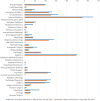Factors Influencing US Allopathic Medical Students to Choose Pathology as a Specialty
- PMID: 33110939
- PMCID: PMC7557358
- DOI: 10.1177/2374289520951924
Factors Influencing US Allopathic Medical Students to Choose Pathology as a Specialty
Abstract
The SARS-CoV-2 pandemic has highlighted the crucial role of pathologists in the health care system at a time of significant decline in the number of US medical students matching to pathology residency positions. To understand this decline, a national survey of fourth-year US allopathic medical students was conducted to assess experiences, knowledge, and attitudes of pathology and factors that impact specialty choice. Participating in a separate pathology course did not increase the probability of choosing pathology. Experiences significantly associated with choosing pathology included clinical or research opportunities in pathology during the last 2 years of medical school, autopsy observation/participation, and participation in pathology interest groups. Many respondents felt they were not sufficiently exposed to pathology to consider it as a specialty. Those who considered pathology but did not choose it were less likely to report understanding the activities of pathologists and being recruited by pathology faculty and more likely to express a preference for more direct patient contact as compared to those entering pathology. In general, respondents agreed that pathology has a good work-life balance and a satisfying degree of intellectual challenge. On the other hand, respondents generally agreed that information on social media and perception of the pathology job market do not seem to be positive and few agreed that pathology is a highly regarded specialty. We identify steps to address these issues and increase the number of US medical students choosing pathology as a specialty crucial to the future of medicine and public health.
Keywords: career choices; medical student; pathology; pathology residency; specialty choice.
© The Author(s) 2020.
Conflict of interest statement
Declaration of Conflicting Interests: The author(s) declared no potential conflicts of interest with respect to the research, authorship, and/or publication of this article.
Figures








References
-
- Results and Data: 2019 Main Residency Match. National Resident Matching Program. Published 2019 Accessed June 13, 2020 https://mk0nrmp3oyqui6wqfm.kinstacdn.com/wp-content/uploads/2019/04/NRMP....
-
- Results and Data: 2020 Main Residency Match. National Resident Matching Program. Published 2020 Accessed June 13, 2020. https://mk0nrmp3oyqui6wqfm.kinstacdn.com/wp-content/uploads/2020/05/MM_R....
-
- Vance RP, Prichard RW, Smith RD. Pathology trainee manpower: APC program directors’ questionnaire, 1989 results. Hum Pathol. 1991;22:1067–1076. - PubMed
-
- Smith RD, Prichard RW. A survey of first-year pathology residents: factors in career choice. Hum Pathol. 1987;18:1089–1096. - PubMed
-
- Vance RP, Prichard RW, Smith RD. Recruitment of pathology trainees. Recent trends from the 1989 Association of Pathology Chairmen’s Survey of first-year pathology residents. Arch Pathol Lab Med. 1991;115:1097–1106. - PubMed
LinkOut - more resources
Full Text Sources
Miscellaneous

